CAA News Today
CAA 2018: Los Angeles Travelogue
posted by CAA — May 03, 2017
Director of Programs Tiffany Dugan and I just returned from a week in Los Angeles to make plans for CAA’s Annual Conference in 2018.
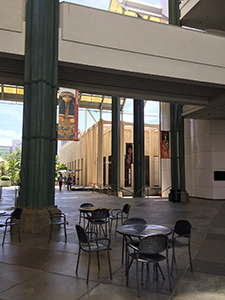
Los Angeles County Museum of Art
Scheduled for February 21-24 at the LA Convention Center, the 106th CAA Annual Conference promises to be one of the strongest ever. When the online session submissions portal closed last week, we had more than 800 submissions – one of the largest numbers in recent years. The Annual Conference Committee is reviewing the submissions this month and will be making final selections.
Based on past conference attendance, we anticipate more than 4,000 conference attendees in Los Angeles. We expect to schedule more than 250 sessions and over 200 events, including meetings, receptions, and tours. To house everyone, we secured three principal hotels, all within walking distance of the Convention Center, guaranteeing 6,000 guest nights.
We visited with the staffs and toured the Westin Bonaventure, Millennium Biltmore LA, and JW Marriott. Hotel rooms for the conference will range from $139 to $269 a night, depending on which hotel you select and the type of room you want. The John Portman designed Westin Bonaventure will be our host hotel and has the cool elegance reflecting the beginning of LA’s downtown revival in the mid-1970s. The Biltmore, which opened in 1923, reflects the opulence and beaux-arts style from LA’s golden age as the film industry was in its burgeoning stage. The new, swank JW Marriot is closest to the Convention Center and at the door of all the urban excitement of L.A. Live. All three hotels are within walking distance of the Convention Center. And the Westin even has a good cup of coffee below $2 in the lobby!

Food trucks in front of the Broad
Near the hotels, we found lots of great restaurants – everything from a hearty breakfast at the Original Pantry Café (which is open 24 hours) to the Blue Cow Kitchen & Bar, Bunker Hill Bar & Grill, Bottega Louie, Eat.Drink.Americano, and Water Grill. Food trucks are on virtually every corner (you have to try the sushi burrito). And there are plenty of artisanal coffee shops as well. In the coming months we will be working on setting up discounts at local restaurants and businesses for our attendees. Our hosts at the LA Convention Center gave us a great tour and we were able to see where the registration area, book and trade fair, and sessions rooms will be. We were able to secure more creature comforts like additional seating between sessions for impromptu conversations, charging stations for phone and laptops, and a quiet room to decompress from the hustle and bustle of the conference.
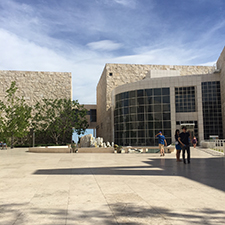
Getty Center
The Getty Museum, LACMA, and MOCA all opened their doors to us and we had great meetings. Each institution is looking forward to CAA 2018 and is making plans to ensure that your visit is meaningful. We met with leaders at UCLA and USC. In upcoming trips, we will be meeting with leaders at the Norton Simon Museum, The Huntington Library, Hammer Museum, Fisher Museum, and The Broad, as well as Otis College of Art and Design, Pasadena City College, Santa Monica College, and many others.
We also toured other cultural organizations including REDCAT, The Brewery Artist Lofts, Japanese American Museum, Chinese American Museum, 18th Street Arts Center, A+D Architecture and Design Museum, Craft and Folk Art Museum and many others. They are looking forward to welcoming CAA members to visit during the conference. We are planning on a day of programing for local LA area artists at the Annual Conference similar to what we did in NYC this year.
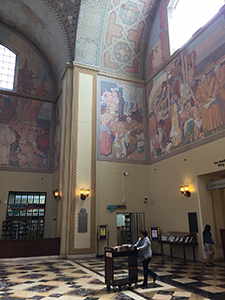
Los Angeles Public Library
Colleges and universities interested in holding reunions and receptions at the Annual Conference will also be able to find great spaces for their events. While there are some beautiful rooms available at the CAA hotels, we saw great spaces at the Hilton Checkers (check out the roof top terrace), the LA Public Library (check out the rotunda and courtyards), the gallery district in Chinatown (check out the Charlie James Gallery and A.G. Geiger Fine Art Books), and Hauser & Wirth. There are plenty of galleries in Hollywood and the Arts District, which will be available as well. We will keep adding to this list to create alternative reception options. Since the weather will be mild, there will be plenty of opportunities to sneak away from the Conference Center and check out what LA has to offer.
If you have not been to LA in a while, you will be happy to discover that getting around is easier than ever. While your CAA membership can get you a discount on an Avis rental car, ride sharing programs such as Uber and Lyft are popular and often cost less than $5 per trip between key cultural locations. LA has also been making great progress on its public transportation system as Metro stations are popping up everywhere.
Many thanks to Annual Conference Chair Judith Rodenbeck and CAA Regional Reps John Tain and Neha Choksi, who, along with Anu Vikram and Niku Kashef, made lots of great recommendations. If you have any more ideas of places you would like to see, just let Tiffany or me know.
Finally, we’ve pulled together all the details for the Getty sponsored Pacific Standard Time and will be offering that information in the months to come. You may want to arrive earlier to make sure that you take in as much as you can. President’s Day weekend is just before the Annual Conference. Be sure to watch CAA News for more updates about the conference as we solidify our planning.
Hunter O’Hanian
Executive Director
CAA Members Win NEH Summer Stipends
posted by CAA — April 13, 2017
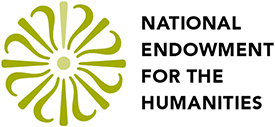 On March 29, the National Endowment for the Humanities (NEH) announced funding for 208 humanities projects totaling $21.7 million. These grants include programs that support international collaboration, engage students in interdisciplinary courses, and help veterans.
On March 29, the National Endowment for the Humanities (NEH) announced funding for 208 humanities projects totaling $21.7 million. These grants include programs that support international collaboration, engage students in interdisciplinary courses, and help veterans.
Among the recipients are the following CAA members, all of whom received a $6,000 Summer Stipend to work on their various research projects:
- Marie-Stéphanie Delamaire of the Winterthur Museum, Garden, and Library in Winterthur, Delaware, for “Diderot and d’Alembert’s Encyclopedia and the Color Printing Revolution: A Translation and Critical Study”
- Jennifer Germann of Ithaca College in Ithaca, New York, for “A Study of the Portrait of Dido Elizabeth Belle and Lady Elizabeth Murray, an 18th-century British Artwork”
- Laura Morowitz of Wagner College in Staten Island, New York, for “Art Exhibitions in Vienna, Austria, during the Nazi Occupation”
- Allie Terry-Fritsch from Bowling Green State University in Bowling Green, Ohio, for “Cosimo de’Medici, Fra Angelico, and the Public Library of San Marco”
- Anne Verplanck of Pennsylvania State University in Harrisburg for “The Business of Art: Transforming the Graphic Arts in an Age of Mechanical Reproduction”
These awards come just weeks after President Donald J. Trump’s administration released a budget proposal calling for the elimination of the NEH, the National Endowment for the Arts, the Department of Education’s international education programs, the Institute for Museums and Library Services, and the Woodrow Wilson International Center for Scholars.
Our attention now turns to Congress, which can fund these programs despite the administration’s proposals. We have been heartened that these programs—which have been supported by presidents of both parties—have seen growing support in Congress in recent years. Indeed, over the past two years, the Republican-controlled Congresses have supported increases for the NEH.
CAA 2017 Convocation, President’s Address: “Art Matters”
posted by Suzanne Preston Blier, President, the College Art Associatio — February 24, 2017
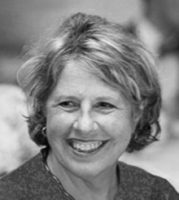 Art Matters. Art has always mattered. Whether we are art scholars or artists, critics or designers, gallery goers or museum professionals, art matters to all of us a great deal. Equally importantly, art matters – critically – to the societies in which we live and work. Fifty years ago this week (February 14,1967) as Aretha Franklin recorded her soon to become hit song, Respect, and Martin Luther King, Jr. prepared to denounce the Vietnam War in an April 4th New York city religious service, Faith Ringgold was creating her celebrated Black Light series, addressing the impact of race riots and other issues of the era. More recently, in 1990 when South African Apartheid finally ended, and Nelson Mandela and other political prisoners were released from incarceration, the important work of South African artists – black and white, men and women –in bringing inequality and racism into public view began to be broadly acknowledged. Within the last few weeks, the Museum of Modern Art began a project to rehang works by artists from majority-Muslim nations facing travel bans to this country. Art matters.
Art Matters. Art has always mattered. Whether we are art scholars or artists, critics or designers, gallery goers or museum professionals, art matters to all of us a great deal. Equally importantly, art matters – critically – to the societies in which we live and work. Fifty years ago this week (February 14,1967) as Aretha Franklin recorded her soon to become hit song, Respect, and Martin Luther King, Jr. prepared to denounce the Vietnam War in an April 4th New York city religious service, Faith Ringgold was creating her celebrated Black Light series, addressing the impact of race riots and other issues of the era. More recently, in 1990 when South African Apartheid finally ended, and Nelson Mandela and other political prisoners were released from incarceration, the important work of South African artists – black and white, men and women –in bringing inequality and racism into public view began to be broadly acknowledged. Within the last few weeks, the Museum of Modern Art began a project to rehang works by artists from majority-Muslim nations facing travel bans to this country. Art matters.
As the one hundred and fifth College Art Association’s Annual Conference gets underway, it is imperative that we reflect on these and related art issues, on the close connections between art making and activism and the vital roles that artists, art scholars and other professionals play in tackling critical issues of the day, whether it be war, racism, sexism, or other forms of discrimination and ethical derogation. Art Matters. It serves as a vital site not only of engagement and resistance, advocacy and education, problem solving and invention, but also as a vital means of opening up and re-envisioning the world around us. Art matters to us both as individuals and as part of the societies in which we live and work. In an era of increasing attacks not only on the humanities, social sciences, and sciences, but also on the arts, the importance of CAA as the leading organization that brings together practitioners and scholars within the same broad umbrella is all the more important. CAA offers a unique platform to reengage at the local, national, and international level. The so-called STEM fields (science, technology, engineering and math) are important, but they do not overshadow the arts and humanities. Indeed, throughout history, each has often enhanced the other.
Arts Matter. Yet I have a confession: there was a key moment in my life when I did not feel this. It was the summer after my Freshman year in college at the University of Vermont. I was working in the Senate when one bleak morning I found myself in tears standing in Dupont Circle watching as Bobby Kennedy’s body arrived here in the hearse after his assassination. Martin Luther King Jr. had been shot a few months earlier. I returned to college that Fall but concluded soon after that art history and studio art were simply not enough. I quit college at the end of that year to join the Peace Corps. It was here, in Africa, where I first realized politics and art were integrally co-joined. Every book I read on African art was worse than the last. The field needed a correction, art history needed a correction, and after my two-year term ended, I returned home to finish my degree and make plans to attend graduate school with a focus on African art.
CAA then, as today, was a big deal. Elation and genuine fear were my initial emotions when my first CAA paper proposal was accepted– on a politically fraught panel addressing Semiotics and Art chaired by Henri Zerner. Much later we would become colleagues. These kinds of connections are part of what makes CAA so important. For me, a timely Art Bulletin article no doubt helped with tenure. But well before then I felt it was important to engage more formally with CAA – as much for African Art as anything else. It was for that reason that I ran for the CAA Board of Directors – and years later ran a second time. When I was a graduate student, many still believed that Africa had no arts outside of Egypt, and Egypt itself was part of a strange exo-African nether world somewhere between Mesopotamia and Greece. African art, if it was considered art at all, was assumed to be primitive. CAA for me was where the real political work began, through CAA board connections, I and others persuaded the editor at Abrams to drop the “Primitive Art” chapter from Janson’s best-selling History of Art textbook. In due course, African and African diaspora arts, and those who made and studied them, began reshaping not only art departments around the country, but also exhibitions, major journals, book publications and key prizes within CAA and other organizations. It was CAA that played a central and ongoing role in this.
What had begun for me at CAA as an engagement about my field, soon blossomed into other issues – open access to museum collections in publishing for example. When I was a board member initially, one of our group began to work with the Metropolitan Museum to make their art photographs accessible on the web. This effort continued and on February 7th, one week ago, the Metropolitan announced that all images of public-domain works in the Met collection will now be available under Creative Commons. This is a huge step forward that will benefit us all. So too has been CAA’s path-forging efforts on Fair Use one of our most important and indeed revolutionary undertakings, for which I and others already are seeing considerable savings in terms of finances and time.
Art Matters. CAA members working together have achieved important ends. But we can and must do more. Art access inequality is not the only issue to attend to. Access to quality higher education is a vital concern for both us and our students, as are questions of student loan fees and affordability, along with the ability of professionals in our field to gain a viable living and secure employment in educational and art-linked institutions. I benefitted from my undergraduate training at a then inexpensive public university; my graduate school education would not have been possible without affordable student loans. I could not have written my Ph.D. without a government funded Fulbright fellowship. For me and many others, book projects would not have been completed without an NEH grant or others at tax supported institutions such as CASVA, the Clark, and the Getty. Museum exhibitions funded by both NEA and NEH are critical to what we do, and these same museums bring in billions of dollars in revenue to local cities and towns.
Art matters. And this is where CAA is critical as an organization, focusing with a new sense of urgency not only on the longstanding programs where we have excelled but also speaking out on core issues that are important to all of us – such as diversity, equal access, and sustainability. Social Activism is a key part of CAA’s Strategic Plan now. As we move forward, changes in CAA that are already underway and will become more evident shortly will help make our organization even stronger and more engaged – from the reenergized annual conference, to a far more dynamic web presence, from larger roles for our affiliated societies, to added benefits that will help members in their professional and personal loves. Art Matters. It matters to us. It matters to the communities and broader societies in which we live and work.
Suzanne Preston Blier

2017 Recipients of CAA’s Awards for Distinction
posted by admin — January 09, 2017
CAA announces the recipients of the 2017 Awards for Distinction, which honor the outstanding achievements and accomplishments of individual artists, art historians, authors, conservators, curators, and critics whose efforts transcend their individual disciplines and contribute to the profession as a whole and to the world at large.
CAA will formally recognize the honorees at a special awards ceremony to be held during Convocation at the 105th Annual Conference in New York, on Wednesday, February 15, 2017, at 5:30 PM. See the conference website for full details.
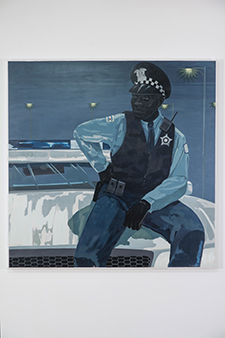
Kerry James Marshall, Untitled (policeman), 2015, acrylic on PVC panel, 60 x 60 inches, 60 9/16 x 60 1/2 x 2 3/4 inches (framed) © Kerry James Marshall. Courtesy of the artist and Jack Shainman Gallery, New York.
Among the winners this year is Kerry James Marshall, recipient of the 2017 CAA Artist Award for Distinguished Body of Work. In his 35-year career painting and making art, Marshall has depicted the African American experience through a medium that has often overlooked the lives of black Americans. His current retrospective at the Met Breuer, titled “Kerry James Marshall: Mastry” (October 25, 2016–January 29, 2017), brings together nearly 80 works by Marshall. Holland Cotter in The New York Times wrote of the show glowingly: “Mr. Marshall has absorbed enough personal history, American history, African-American history and art history to become one of the great history painters of our time.”
Kerry James Marshall biography
Faith Ringgold, the winner of the 2017 CAA Distinguished Artist Award for Lifetime Achievement, is widely considered one of the most influential living African American artists. Born in Harlem in 1930, she is an artist, feminist, activist, and educator who makes use of a variety of media, including painting, quilts, sculpture, performance, and children’s books. Civil Rights, racial justice, feminism, and art history are consistent themes. Ringgold earned BS and MA degrees in art from the City College, the City University of New York, and taught in the NYC public school system for almost twenty years. Since the 1970s Ringgold has been an activist and cofounder of several feminist and antiracist organizations, along with artist Poppy Johnson, art critic Lucy Lippard, and her daughter Michelle Wallace, among others.
Full list of 2017 CAA Awards for Distinction recipients
Charles Rufus Morey Book Award
Kishwar Rizvi
The Transnational Mosque: Architecture and Historical Memory in the Contemporary Middle East
University of North Carolina Press
Alfred H. Barr Jr. Award
Ruth Fine, ed.
Procession: The Art of Norman Lewis
Pennsylvania Academy of the Fine Arts, in association with the University of California Press
Alfred H. Barr Jr. Award for Smaller Museums, Libraries, Collections, and Exhibitions
Carmella Padilla and Barbara Anderson, eds.
A Red Like No Other: How Cochineal Colored the World
Skira Rizzoli, in association with the Museum of International Folk Art
Arthur Kingsley Porter Prize
Christine I. Ho
“The People Eat for Free and the Art of Collective Production in Maoist China”
The Art Bulletin, September 2016
Frank Jewett Mather Award for Art Criticism
Laura U. Marks
Hanan al-Cinema: Affections for the Moving Image
MIT Press
Distinguished Feminist Award
Joan Marter
Art Journal Award
Amy A. DaPonte
“Candida Höfer’s Türken in Deutschland as ‘Counter-publicity’”
Art Journal, Winter 2016
Distinguished Teaching of Art Award
Virginia Derryberry
Distinguished Teaching of Art History Award
Patricia Mainardi
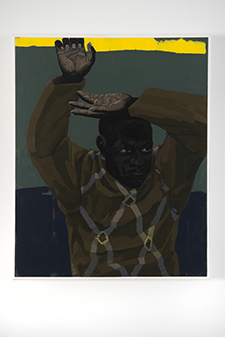
Kerry James Marshall, Untitled (Looking Man), 2016, acrylic on PVC panel, 30 1/2 x 24 1/2 inches, © Kerry James Marshall. Courtesy of the artist and Jack Shainman Gallery, New York.
Artist Award for Distinguished Body of Work
Kerry James Marshall
Distinguished Artist Award for Lifetime Achievement
Faith Ringgold
CAA/American Institute for Conservation Award for Distinction in Scholarship and Conservation
Tom J. S. Learner
Morey and Barr Award Finalists
CAA recognizes the 2017 finalists for the Charles Rufus Morey Book Award and the Alfred H. Barr Jr. Awards for their distinctive achievements:
Charles Rufus Morey Book Award Finalists
- Niall Atkinson, The Noisy Renaissance: Sound, Architecture, and Florentine Urban Life, Pennsylvania State University Press
- Elizabeth Kindall, Geo-Narratives of a Filial Son: The Paintings and Travel Diaries of Huang Xiangjian (1609–1673), Harvard University Asia Center
Alfred H. Barr Jr. Award Finalists
- Helen Molesworth, ed., Kerry James Marshall: Mastry, Museum of Contemporary Art, Chicago, and Skira Rizzoli (honorable mention)
- Barbara Haskell and Harry Cooper, Stuart Davis: In Full Swing, National Gallery of Art, Whitney Museum of American Art, and DelMonico Books
- Alisa LaGamma, Kongo: Power and Majesty, Metropolitan Museum of Art
- Adrian Sudhalter, Dadaglobe Reconstructed, Kunsthaus Zürich and Scheidegger & Spiess
Alfred H. Barr Jr. Award for Smaller Museums, Libraries, Collections, and Exhibitions Finalists
- Andreas Marks, ed., Tōkaidō Texts and Tales: Tōkaidō “gojūsan tsui” by Kuniyoshi, Hiroshige, and Kunisada, University Press of Florida (honorable mention)
- Zdenka Badovinac, Eda Čufer, and Anthony Gardner, eds., NSK from “Kapital” to Capital: Neue Slowenische Kunst—An Event of the Final Decade of Yugoslavia, Moderna galerija and MIT Press
- Geoffrey Batchen, Emanations: The Art of the Cameraless Photograph, Govett-Brewster Art Gallery and DelMonico Books
- Valérie Rousseau, Art Brut in America: The Incursion of Jean Dubuffet, American Folk Art Museum
Contact
For more information on the 2017 Awards for Distinction, please contact Tiffany Dugan, CAA director of programs. Visit the Awards section of the CAA website to read about past recipients.
Top News in 2016 from the Art and Academic Worlds
posted by Christopher Howard — December 28, 2016
As 2016 comes to a close, CAA would like to wish a safe and happy holiday season to its members, subscribers, partners, and other professionals in the visual arts. As we reflect on the past twelve months, the association would like to offer readers a look at the most accessed articles in the weekly CAA News email from the past year.
I Survived My First Year on the Tenure Track, but I’m Ready to Bail!
Now that I’ve survived my first year in a tenure-track position at a small liberal-arts college, all I want to do is curl up in a ball. A nonacademic position is opening up in my hometown. If I got the job, I’d still have adjunct faculty status and be able to supervise grad students. I’d also probably get a 30- to 50-percent salary increase. (Read more from Vitae.)
Advice for the Newly Tenured
I would love to share with you the three biggest mistakes that I observe newly tenured faculty members make. If you know what those mistakes are, then you are not only far less likely to make them, but you also have the opportunity to experiment with new ways of thinking and working that will help you to truly enjoy your tenured status. (Read more from Inside Higher Ed.)
How Many Hours a Week Should Academics Work?
How many hours do you work in a week? Many academics feel overworked and exhausted by their jobs. But there is little evidence that long hours lead to better results, while some research suggests that they may even be counterproductive. (Read more from Times Higher Education.)
The Disappearing Humanities Jobs
The arrival of annual reports on the job market in various humanities fields this year left many graduate students depressed about their prospects and professors worried about the futures of their disciplines. This week, the American Academy of Arts and Sciences released several new collections of data that show that these declines, part of a continuing pattern, are far more dramatic when viewed over a longer time frame. (Read more from Inside Higher Ed.)
Publish or Be Damned
The London office of Yale University Press has been a leading publisher of art history in the English language. When we heard of a new book planned by a leading scholar in the field, we expected to learn that Yale had pledged to publish it. When a bright graduate finished his or her dissertation, we hoped that Yale would publish it. (Read more from the Burlington Magazine.)
Racially Charged St. Louis Contemporary Art Museum Show Sparks Outrage
Racially charged works at a Contemporary Art Museum in Saint Louis exhibition have some calling for boycotts and the resignation of the museum’s chief curator. The museum has opted to build walls around the controversial pieces of art. The show will remain up and visitors will have access to all of the work. (Read more from Fox 2 News.)
Learning from My Teaching Mistakes
As a professional failed academic, I get asked if my decisions in graduate school were to blame for my failures. The answer is, of course, yes and no. Similar to anyone else with a PhD who isn’t delusional or lying, my relationship with my doctorate contains multitudes of defeats. And now, six years after I finished, I’ve got some perspective on both what I screwed up and what I didn’t. (Read more from Vitae.)
Syllabus Adjunct Clause
Here is a sample adjunct clause that can be inserted into any syllabus for courses taught by temporary faculty. Please keep in mind that since situations differ from school to school—and even from department to department—the following may not be universally applicable as written. Therefore, if you decide to use it, make the necessary changes to accurately reflect your own situation. (Read more from School of Doubt.)
When Students Won’t Do the Reading
Is there a more common lament among college instructors than “Why won’t students just do the reading?” It’s an important and difficult question. In my experience, many students understand, at least in the abstract, that the reading is important. (Read more from Inside Higher Ed.)
Why You Weren’t Picked
There are two major downsides to not getting that tenure-track job you applied for. The second one is the less obvious but may be the more pernicious in the long run: no one will tell you why you weren’t chosen. (Read more from the Chronicle of Higher Education.)
Why Most Academics Will Always Be Bad Writers
For at least a generation, academics have elaborately and publicly denounced the ponderous pedantry of academic prose. So why haven’t these ponderous pedants improved, already? The critics would say the ponderous pedants are doing it on purpose. (Read more from the Chronicle of Higher Education.)
Balancing the Books at Yale University Press in London
A letter signed by over 290 academics, curators, and writers expressed a “sense of shock at the restructuring of Yale University Press in London, particularly as it affects the renowned art books department.” Having learned that two commissioning editors were to be made redundant, the signatories asked for reassurance about Yale’s commitment to scholarly art publishing and for the rationale for the changes. (Read more from Apollo.)
How to Be an Unprofessional Artist
No one likes being called an amateur, a dilettante, a dabbler. “Unprofessional” is an easy insult. The professional always makes the right moves, knows the right thing to say, the right name to check. Controlled and measured, the professional never sleeps with the wrong person or drinks too much at the party. (Read more from Momus.)
Make No Mistake, Art History Is a Hard Subject. What’s Soft Is the Decision to Scrap It
In the UK, art history A-level is to be scrapped in 2018. The decision taken by the exam board AQA seems related to the Conservative government’s policy of ranking subjects by perceived relative difficulty, using an analogy of “soft” and “hard” that may be designed to belittle students and teachers who have apparently taken the easy way out. (Read more from Apollo.)
Essential PhD Tips: Ten Articles All Doctoral Students Should Read
If you’re still deciding whether to study for a doctorate, or even if you’re nearing the end of your PhD and are thinking about your next steps, we’ve selected ten articles that you really should take a look at. They cover everything from selecting your topic to securing a top job when your years of hard graft come to an end. (Read more from Times Higher Education.)
How to Become a Curator
Start out as an artist instead. In school, you’re always saddled with organizing the group shows, buying the beer, placating fellow artists’ fears, making the invitations, composing the checklist, finding the funding, contacting the press, inviting the audience. Your entire art practice becomes a smudgy line between curating and art, and you grow to feel strange and unnecessary. (Read more from Momus.)
Donald Trump, Taste, and the Cultural Elite
It’s said that taste defines us. The music I like lets you know, to some degree, what kind of person I am. Yet though this year’s presidential election has raised issues of racism, sexism, and classism, not much has been said about taste, and the role it may or may not have played in getting Donald Trump to the White House. (Read more from the Washington Post.)
Black Arts Community Expresses Outrage with Kelley Walker
“This is a mess, and I’m uncomfortable,” said Kat Reynolds as she spoke before the capacity crowd at the Contemporary Art Museum on September 22. The panel of artists and educators—who spoke during the Critical Conversations talk presented by Critical Mass for the Visual Arts—didn’t hold back from voicing their disdain about the art that hung in the very space where the discussion was taking place. (Read more from the St. Louis American.)
What Learning People Really Think about Lecturing
Is there really a war on lecturing going on across higher education? Do learning professionals want to kill the lecture? Read Christine Gross-Loh’s “Should Colleges Really Eliminate the College Lecture?” and you would be forgiven in thinking that there is and that we do. The problem is that her description of the current climate bears little resemblance to reality. (Read more from Inside Higher Education.)
Gallery Defends Kelley Walker, Artist under Fire in St. Louis Exhibit
The New York City–based gallery representing the artist Kelley Walker has responded to the controversy surrounding a racially charged exhibition at the Contemporary Art Museum in Saint Louis, but with a statement that raises more questions than it answers. (Read more from Riverfront Times.)
Should Colleges Really Eliminate the College Lecture?
Despite the increased emphasis in recent years on improving professors’ teaching skills, such training often focuses on incorporating technology or flipping the classroom, rather than on how to give a traditional college lecture. It’s also in part why the lecture—a mainstay of any introductory undergraduate course—is endangered. (Read more from the Atlantic.)
What Happens When a Museum Closes?
Four recently dissolved cultural institutions—the Museum of Biblical Art in New York, the Fresno Metropolitan Museum of Art and Science in California, the Corcoran Gallery of Art in Washington, DC, and the Higgins Armory Museum in Massachusetts—each offer a lesson in how to weather the complex process of closing a museum. (Read more from Artsy.)
Artiquette: Ten Mistakes Not to Make While Promoting Your Art
How do you make it in the art world? It’s a magical formula that involves, talent, drive, grit, and the ability to promote oneself. Unfortunately, talking up your own artwork, projects, and ideas can be a delicate balancing act. To help you walk that line, Artnet News has rounded up a list of mistakes to avoid in self-promotion. (Read more from Artnet News.)
Six Things to Keep in Mind When Applying for Art Grants
With governments cutting funding for the arts, it is getting harder for artists and art institutions to obtain art grants, fellowships, or scholarships. The professional grant writer Ethan Haymovitz has put together a list of things to keep in mind when writing your application. (Read more from Art Report.)
Getting beyond the Anecdote: Research and Art-History Pedagogy
Pedagogical innovations abound in art-history classrooms. National and regional conferences increasingly feature panels of inspirational examples and case studies. These sessions are well attended by instructors eager for new, proven ideas to improve their teaching. The speakers assure this audience of improved student engagement and efficacy at achieving learning outcomes with this or that innovation. But how can they prove it? (Read more from Art History Teaching Resources.)
This Art Historian Teaches FBI Agents and Surgeons How to See
Amy Herman teaches people how to see. Her tools of choice are famous artworks from major art institutions all over the world. Her typical pupils? Cops, FBI officers, medical students, and first responders. Herman teaches a class that helps people fine-tune their observational skills—which often prove critical in solving a crime or conducting open-heart surgery. (Read more from Fast Company.)
Five Strategies Successful Artists Follow to Thrive in Their Careers
As a gallery owner, I’ve been particularly interested in watching the careers of artists who have built strong sales of their work. These artists are able to generate sales that allow them to devote all of their time to their art. They have found ways to make a successful living while at the same time pursuing their passion. (Read more from Red Dot Blog.)
Five Time-Saving Strategies for the Flipped Classroom
I often hear comments like “The flipped classroom takes too much time,” “I don’t have time to devise so many new teaching strategies,” “It takes too much time to record and edit videos,” and “I don’t have time to cover everything on the syllabus.” I also hear “I tried to flip my class, but it was exhausting; so I quit.” If these comments sound familiar, it might be helpful to create margins in your flipped classroom. (Read more from Faculty Focus.)
How Do I Get My Foot in the Art World?
I’m a recent grad and want to learn more about the art world, so hopefully, one day, I can work in the arts. I didn’t major in art, but I took several art history and art classes and really loved them. I also love going to galleries and museums. Could you give me some suggestions on how to learn more? (Read more from Burnaway.)
Help Desk: Getting Paid for Curatorial Work
I’m a professional curator with over a decade of experience, mostly as a salaried professional. I’d like to do more freelance work, but curators seem to get paid nothing, absurdly little, or astronomical sums. How can I actually get paid for the work I do? (Read more from Daily Serving.)
Museums Are Keeping a Ton of the World’s Most Famous Art Locked Away in Storage
Most of Georgia O’Keeffe’s work is in storage. Nearly half of Pablo Picasso’s oil paintings are put away. Not a single Egon Schiele drawing is on display. Since the advent of public galleries in the seventeenth century, museums have amassed huge collections of art for society’s benefit. But just a tiny fraction of that art is actually open for people to view and enjoy. (Read more from Quartz.)
University of Chicago Strikes Back against Campus Political Correctness
The anodyne welcome letter to incoming freshmen is a college staple, but the University of Chicago took a different approach: it sent new students a blunt statement opposing some hallmarks of campus political correctness, drawing thousands of impassioned responses, for and against, as it caromed around cyberspace. (Read more from the New York Times.)
On Not Reading
The activity of nonreading is something that scholars rarely discuss. When they—or others whose identities are bound up with books—do so, the discussions tend to have a shamefaced quality. Blame “cultural capital”—the sense of superiority associated with laying claim to books that mark one’s high social status. (Read more from the Chronicle Review.)
Medieval Scots Used Art the Way We Use Social Media
Medieval Scots once gave each other postcard-sized artworks to forge social bonds, in the same way we post pictures on social media today, according to new research. The “postcards on parchment”—whose painted images included patron saints, the Virgin Mary and child, and highly decorated lettering—revealed status, allegiances, and values among the wealthy classes in the fourteenth and fifteenth centuries. (Read more from the Scotsman.)
CAA Announces Publication of Code of Best Practices in Fair Use for the Visual Arts
posted by CAA — February 09, 2015
 The College Art Association (CAA) has published the Code of Best Practices in Fair Use for the Visual Arts, a set of principles addressing best practices in the fair use of copyrighted materials based on a consensus of opinion developed through discussions with visual-arts professionals. It will be a vital resource for everyone working in the field, including artists, art historians, museum professionals, and editors. Initiated by CAA in 2012, the multi-year effort has been led by the Code’s authors, Peter Jaszi and Patricia Aufderheide, professors of law and communication studies respectively at American University and the leading experts on the development of codes for communities that make use of copyrighted materials in their professional practices.
The College Art Association (CAA) has published the Code of Best Practices in Fair Use for the Visual Arts, a set of principles addressing best practices in the fair use of copyrighted materials based on a consensus of opinion developed through discussions with visual-arts professionals. It will be a vital resource for everyone working in the field, including artists, art historians, museum professionals, and editors. Initiated by CAA in 2012, the multi-year effort has been led by the Code’s authors, Peter Jaszi and Patricia Aufderheide, professors of law and communication studies respectively at American University and the leading experts on the development of codes for communities that make use of copyrighted materials in their professional practices.
Linda Downs, CAA executive director, said, “The Code is a crucial contribution to the field as a clear statement on best practices in the fair use of copyrighted materials that directly reflects a consensus from the visual-arts community. CAA is grateful to all of the artists, art historians, museum professionals, and editors, among others, who participated in the project so generously with their time and collective knowledge.”
The Code describes the relevance of fair use in five broad areas of the visual arts field:
- Analytic Writing: When may scholars and other writers about art invoke fair use to quote, excerpt, or reproduce copyrighted works?
- Teaching about Art: When may teachers invoke fair use in using copyrighted works to support formal instruction in a range of settings, including online and distance teaching?
- Making Art: Under what circumstances may artists exercise fair use to incorporate copyrighted material into new artworks in any medium?
- Museum Uses: When may museums and their staffs invoke fair use in using copyrighted works—such as images, text, and time-based and born-digital material—when organizing exhibitions, developing educational materials (within the museum and online), publishing catalogues, and other related activities?
- Online Access to Archival and Special Collections: When may such institutions and their staffs claim fair use to create digital preservation copies and/or enable digital access to copyrighted materials in their collections?
DeWitt Godfrey, CAA president and professor of art and art history at Colgate University, said, “The research undertaken in this project demonstrated that a significant amount of creative and scholarly work has been stunted by a lack of understanding or clear consensus on fair use. This Code provides a straightforward set of principles that will allow those working in the visual arts to determine when they can assert fair use in their work with confidence.”
In January 2014, CAA published Copyright, Permissions, and Fair Use among Visual Artists and the Academic and Museum Visual Arts Communities: An Issues Report, a summary of one hundred interviews with art historians, artists, museum curators, editors, and publishers describing issues related to the use of third-party images in creative and scholarly work. The Issues Report—which revealed significant challenges to creating and disseminating new work because of actual and perceived limitations of copyright—was the subject of ten discussion groups held last summer throughout the country with visual-arts professionals who deal with fair use and copyright issues on a daily basis. The Code is a result of this extensive research.
Peter Jaszi, professor of law in the Program on Information Justice and Intellectual Property at American University’s Washington College of Law, explained that “Although the visual-arts community is impressively diverse, including art-makers, individual scholars, and institutional users, its members came together determined to reach a useful consensus. The Code reflects the range of perspectives and expertise the participants brought to the process.”
Coauthor Patricia Aufderheide, university professor in the School of Communication at American University and director of the Center for Media & Social Impact, said, “Codes of best practices have proven enormously successful in enabling members of other creative communities to do their work well and effectively. They allow individuals to make judgments knowing where they fall in relation to the thinking of their peers—and that lowers risk. Further, codes give museums, broadcasters, insurers, publishers, educational institutions, and their lawyers a new and valuable tool to use in making better, more reasonable assessments of risk.”
During CAA’s 103rd Annual Conference in New York (February 11–14, 2015), the principal investigators of this project and authors of the Code, Patricia Aufderheide and Peter Jaszi, will speak publicly with Judy Metro, editor-in-chief at the National Gallery of Art and chair of CAA’s Committee on Intellectual Property; Jeffrey Cunard, cochair of CAA’s Task Force on Fair Use; and Christine Sundt, editor of Visual Resources: An International Journal of Documentation and former CAA board member. The session, which will take place on Friday, February 13, from 12:30 to 2:00 PM at the New York Hilton Midtown, is free and open to the public.
CAA’s Code of Best Practices in Fair Use for the Visual Arts is funded by the Andrew W. Mellon Foundation with additional support provided by the Samuel H. Kress Foundation.
About CAA
The College Art Association is dedicated to providing professional services and resources for artists, art historians, and students in the visual arts. CAA serves as an advocate and a resource for individuals and institutions nationally and internationally by offering forums to discuss the latest developments in the visual arts and art history through its Annual Conference, publications, exhibitions, website, and other programs, services, and events. CAA focuses on a wide range of advocacy issues, including education in the arts, freedom of expression, intellectual-property rights, cultural heritage and preservation, workforce topics in universities and museums, and access to networked information technologies. Representing its members’ professional needs since 1911, CAA is committed to the highest professional and ethical standards of scholarship, creativity, criticism, and teaching.
For more information please contact Janet Landay, CAA fair use initiative project manager, at 212-392-4420. To contact Patricia Aufderheide or Peter Jaszi, please contact Kelly L. Alexander, director of public relations, American University, at 202-885-5952.


